Creating Allowances
Like add-ons, allowances are optional or mandatory features that can be attached to your core plans in Billsby. Allowances are billed in arrears based on how much was used in the previous billing cycle.
All allowances are unit based and can be billed for using per unit, volume, tiered, ranged or capped pricing models. Each pricing model also allows customers to choose the number of units that will be included in the allowance each billing cycle; this number outlines the amount of times a customer will be able to use a feature free of charge.
For example, if you ran a gym you could charge $10 for each yoga class your customer attends at the end of every billing month. If it was determined, however, that an allowance of 'Classes' included the first five classes of each month, then there would only be an additional charge if the customer exceeded their allowance and attended say, an extra two classes charged at $10 per session.
Capped allowances
Allowances are charged in arrears based on the customer's usage of the allowance throughout their cycle. This is known as the allowance's overage. Capping allowances simply means that you don't let your customers go over a certain number of units for their allowance. So, in the example of a mobile phone network, they may choose to cap the allowance at a predetermined number of minutes, texts and data to not allow customers use any overage. If they wanted to charge for overage, instead of capping the allowance they would set a price for this overage to be charged at the end of the billing cycle.
Creating Allowances
To create an allowance, navigate to the main menu and select Products > Allowances.
Here you'll be able to create your first allowance.
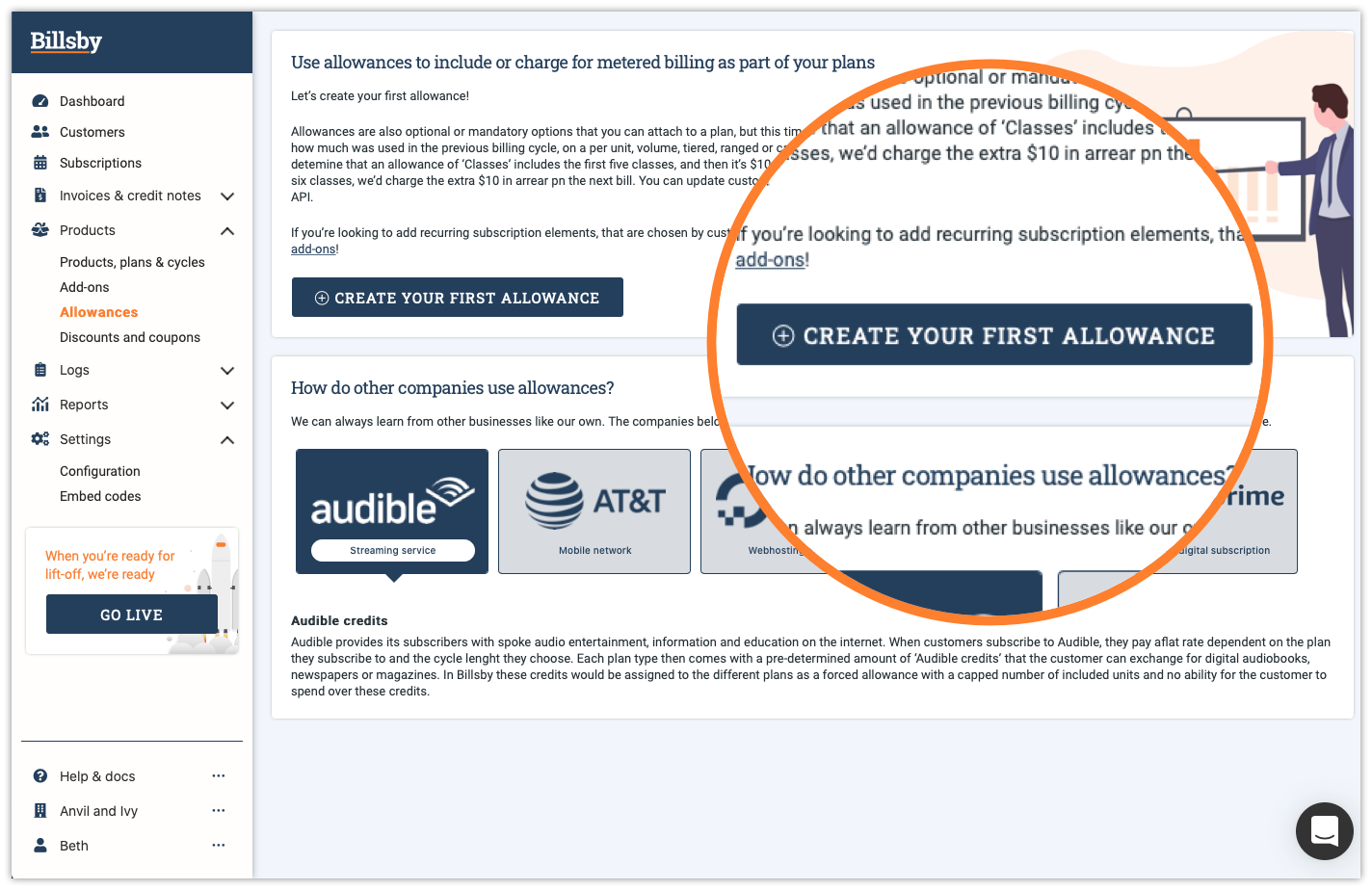
In the section titled, 'Tell us the basics' you will be asked to provide a name, display name, and a description for your allowance
If you decide on a unit based pricing structure for your allowance, you will also need to provide the singular and plural unit name so that we know exactly how to reference it when coordinating with your customers.
The single unit name is the title we'll use when we refer to one unit of your add-on. This name will be shown to your customers in the Billsby Checkout, Self-Service Account Management, relevant emails and invoices, alongside being displayed in the Billsby control panel.
The plural unit name is the title we'll use when we refer to multiple units of your add-on.
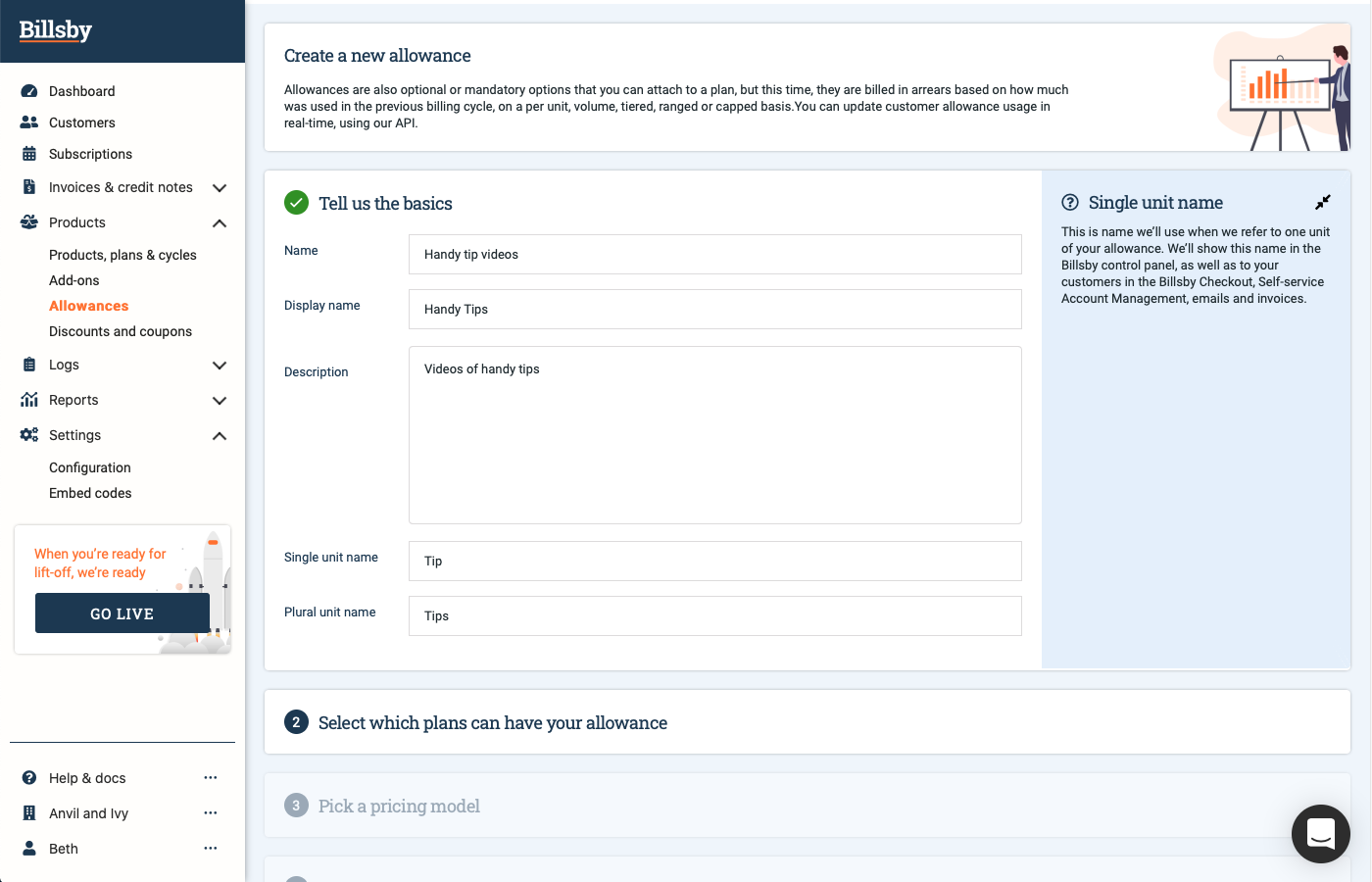
Linking allowances to a plan
Next, you'll need to select which plans can have your allowance, and whether it should be a compulsory element of the plan or not.
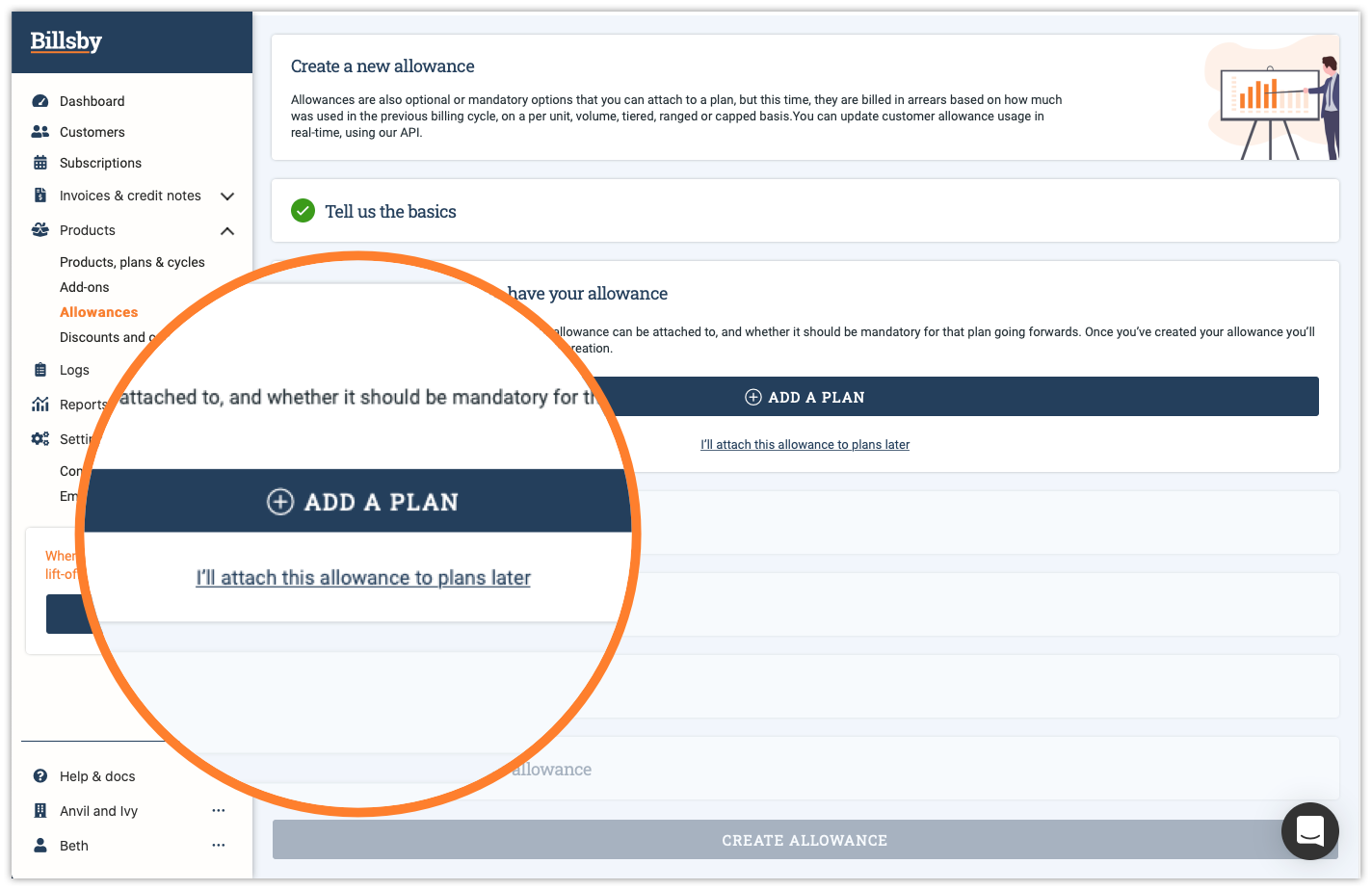
If you want to make the allowance a compulsory element of the plan, then select 'Force allowance with plan'. This will automatically add the allowance to your customer's subscription during the checkout flow and they will not be able to remove it.
If you decide not to make the allowance compulsory then the customer will be free to choose whether they want to include it during the checkout flow or not.
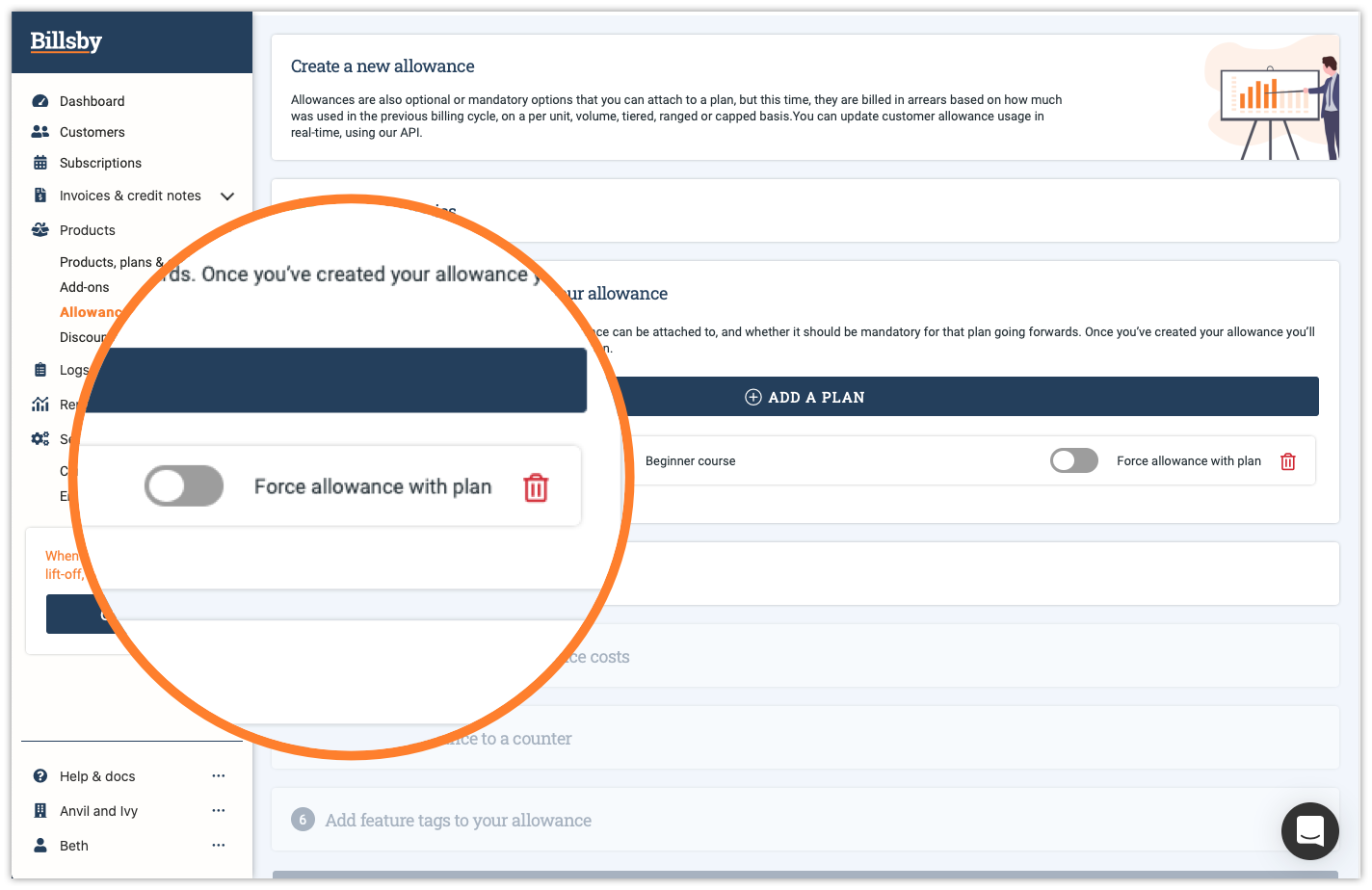
If a customer subscribes to your product during a free trial, all mandatory allowances will also be added to the subscription for no additional cost. By default, however, the customer will not be able to add optional allowances to their subscription during their free trial period.
This restriction can be changed in the Checkout and Account Management section of configuration. To access this, simply navigate to Configuration > Checkout and Account Management > Self-Service and then switch on the toggle labelled 'Manage Allowances'.
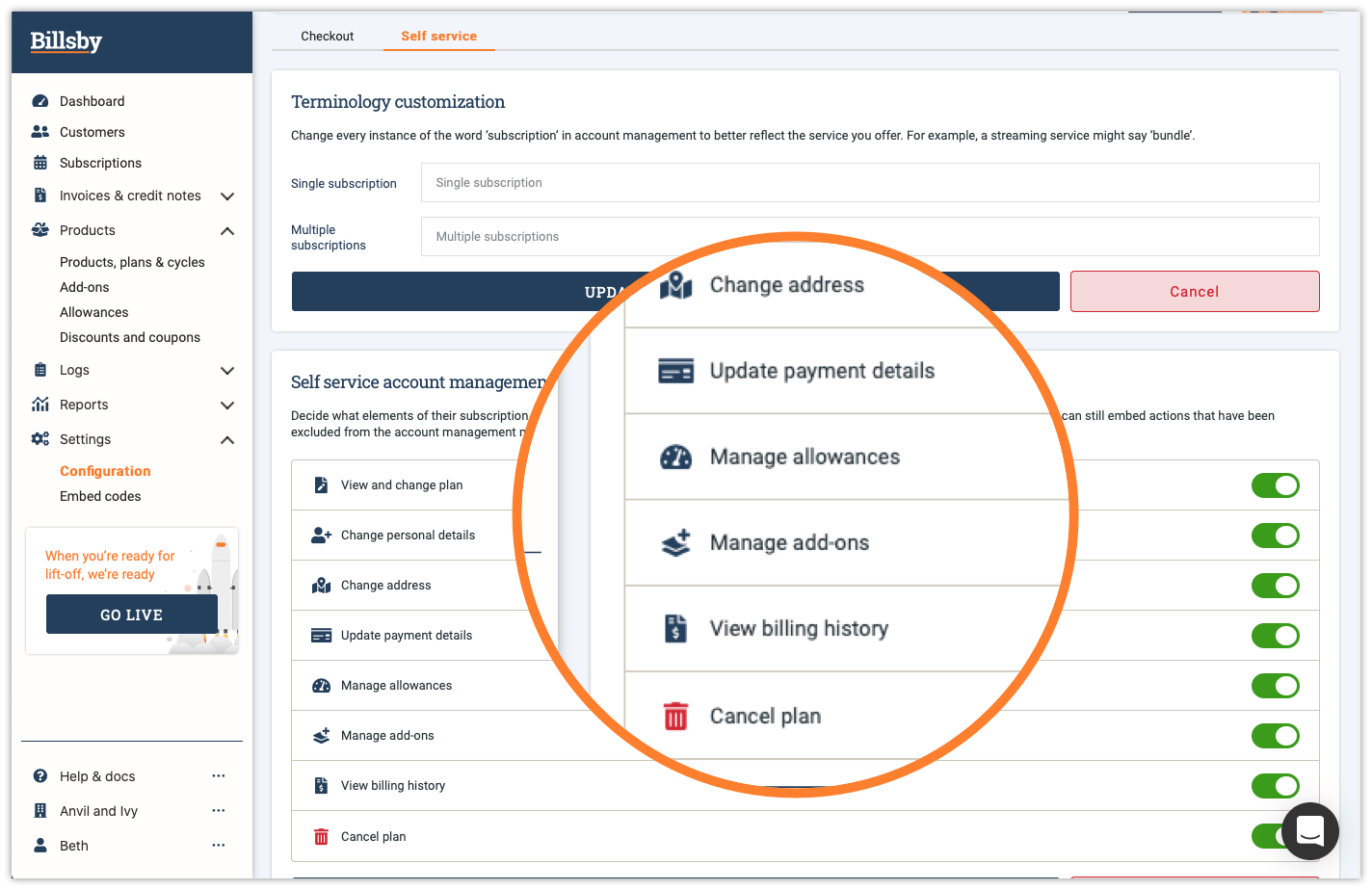
Once you've created your allowance(s), you do not have to immediately attach them to a plan. You can select the button, 'I'll attach this allowance to plans later' to postpone this action.
Pricing model
There's a range of pricing models for you to choose from when creating your allowances such as,
- Flat fee
- Per unit
- Volume
- Tiered
- Ranged
Please note, once you have selected a pricing model, this cannot be changed.
For more information on what each of these pricing structures entail, please refer to our documentation on plans here.
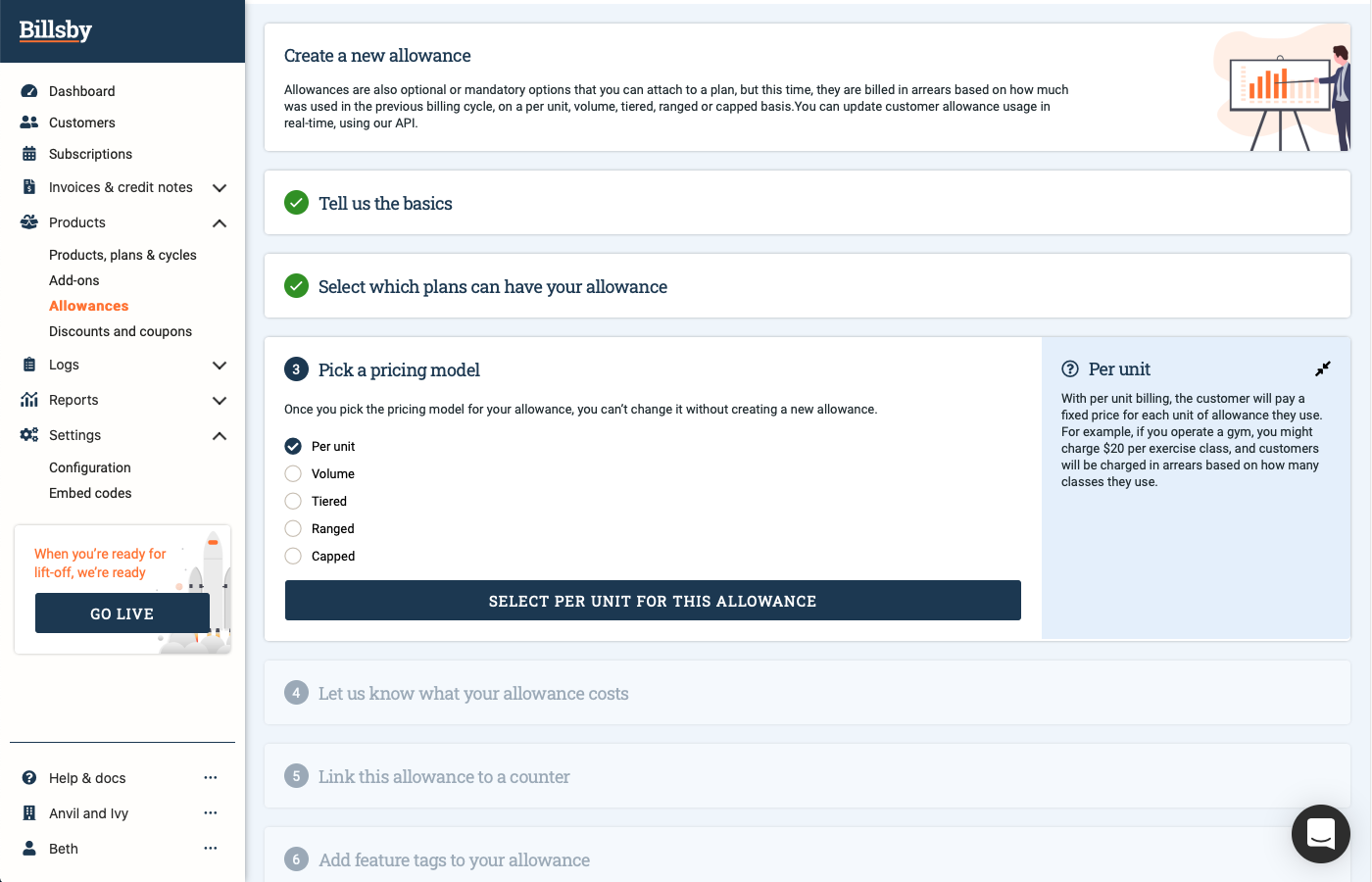
Once you've attached your allowance to a plan you'll be able to set the price for it. This action cannot be completed beforehand as the pricing of the allowance is dependent on the cycle length of the plan it is attached to.
Configuring the cost of the allowance
In order to configure a price for your allowance you should base your figure on the cycle lengths within the linked plan.
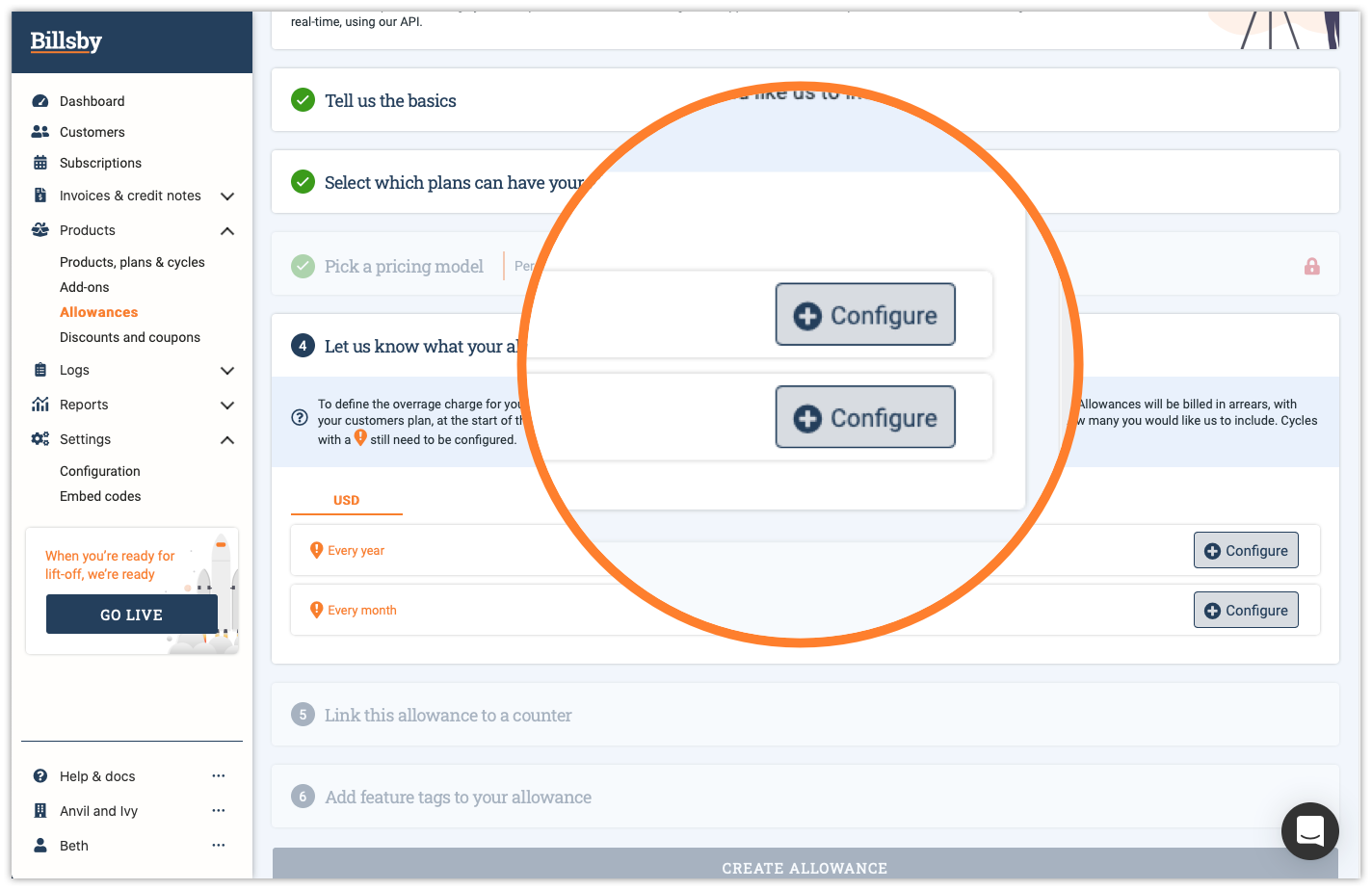
Once you have set-up your add-on you can link it to as many plans as you'd like. If the add-on is linked to multiple plans with the same cycle frequency and currency, then you'll only need to configure the add-on price for that cycle frequency once.
For example, if you have two plans that have the same cycle frequency of once a month, then you'll only need to configure a price for that frequency once, as it can be applied over again.
The configured price should automatically be used across all of the linked plans of that same cycle length and currency.
Here at Billsby, when you link an additional plan to an add-on, we will automatically check for any cycle lengths that have already been configured. If we find a match then we will then assign the previously configured cycle prices to the newly linked plan. Just to save you some time.

However, if the cycle lengths are the same but the currency isn't, then this rule doesn't apply and you will need to configure the cycle prices for your allowances separately, according to each currency.
Linking to a counter
An allowance counter is used in the API to tell us how many units of the allowance each customer has used during their billing cycle, this is what you'll need to link your allowance to so that we can keep up to date on who owes what.
The allowance counter is useful as it enables you to select the same counter for multiple allowance options that bill for the same thing, but charge different prices.
For example, you could have multiple allowance options for yoga classes; one allowance could include five yoga classes and then charge an additional $20 per class after exceeding the allowance, another allowance option could include ten yoga classes but then charge an additional $10.
Despite the difference in charging price, you are still billing for the same thing, yoga classes. So this is the element you need to count to calculate the bill, which means that you are able to use the same counter for these two different allowances.
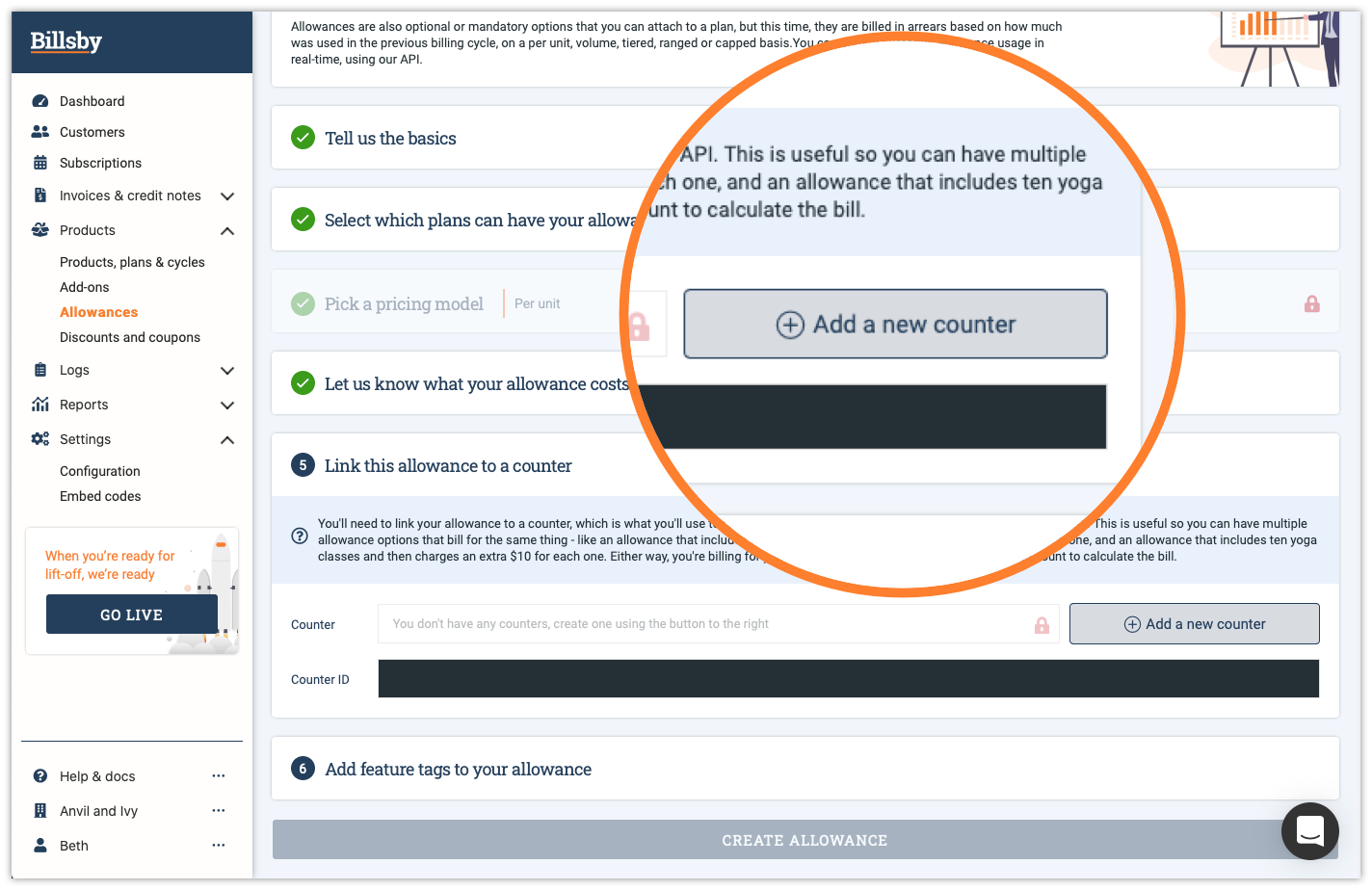
To create a new counter, select 'Add a new counter' and input your chosen name. We will then generate a counter ID that you will be able to use for checking and updating allowances using the API.
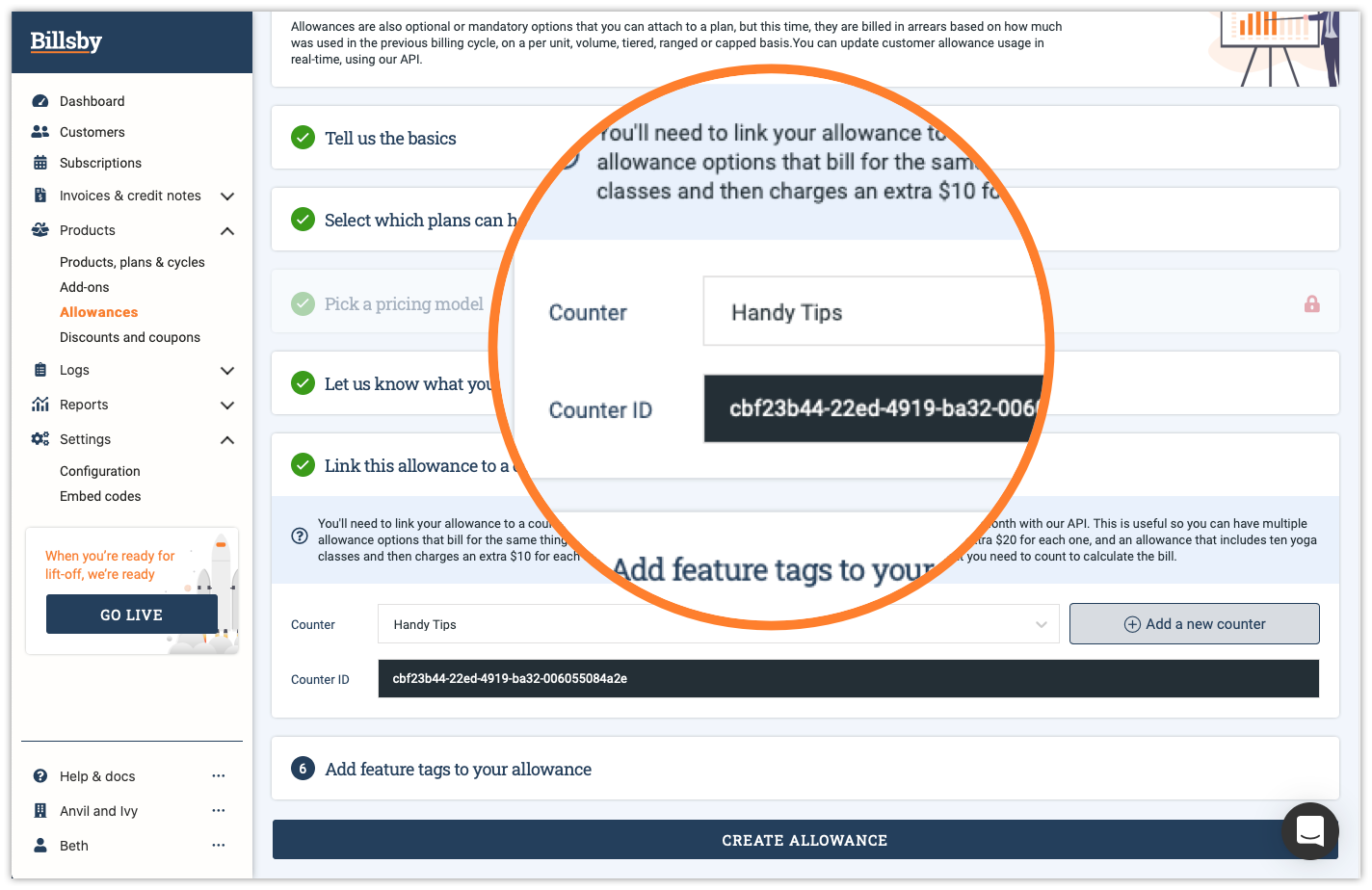
Feature tags
With the implementation of feature tags, this will allow your developers to only think about the features that your customer has, rather than the plan they're on. This will simplify the process of understanding what the customer has access to.
Here's an example of feature tags in action:
| Basic Plan | Premium Plan | Available via allowance? |
|---|---|---|
| Gym access | Gym access | No |
| Towel service | No | |
| HIIT classes | Yes |
Because 'HIIT classes' are also available through an allowance in addition to the premium plan, this means that customers on a basic plan can buy a 'HIIT classes' allowance for the month. Your developers just have to check for the 'HIIT' feature tag when the customer tries to sign up for a class.
Next, if the customer does have an allowance then the developers will need to check how many classes they have left on their account and after that, they will need to update the customer's allowance.
So, in summation, this example would've required three API calls:
- How many HITT classes does this customer have included (GET subscription)?
- How many have they used (GET counters)?
- Add another unit to the counter (PUT counters)
Removing an optional allowance
An optional allowance can be removed in two ways. Customers are able to remove the optional allowance themselves by using the self service account management feature or, alternatively, you can remove it for them directly through the subscriptions page in the Billsby control panel.
If an allowance is removed mid-cycle this will only come into effect at the start of the customer's next cycle. This means that we'll still still count the usage of the allowance for the remainder of the cycle and then charge for it at the beginning of their next billing cycle as this avoids the process of having to give customers pro-rated refunds mid-cycle.
Deleting an allowance
In order to completely delete an allowance, you must make sure that the allowance is not linked to any of your plans in Billsby. You will not be able to delete the allowance until you have unlinked all of your plans.
Allowance usage and overage
Tracking allowance usage
Customers' usage of allowances are tracked using the API which you can also use to report usage for allowances in real-time, rather than counting it yourself. If you would rather manually update this, simply navigate to Configuration > Checkout and Account Management > Self-Service, and then switch on the toggle called 'Manage Allowances'. You can also manually update a customer's allowance usage in the 'Allowances' tab of their individual subscription page.
Changing plans
If a customer decides to change the plan they are subscribed to, then any allowance they have should not be added to their new subscription but re-added manually. To do this, they will also have to pay any outstanding allowance overage.
FAQs
How do I link an allowance to a plan?
If you head to Products > Allowances you can add an allowance to one of your plans. You either need to create an add-on by selecting 'Add a new allowance' in the top right-hand corner of the screen. In the allowance creation process step 2 will let you attach your allowance to a plan.
If the allowance already exists, simply hit 'Edit' on the allowance and you'll see a list of all the plans with the selected allowance. Just hit 'Add a plan' and you'll see all the plans that you can attach to the allowance.
Can I change the pricing model of an allowance?
No, once you have selected a pricing model, this cannot be changed without creating a new allowance.
How do I delete an allowance?
To delete an allowance, the allowance must not be linked to any of your plans. To unlink plans from your allowance, head Products > Allowances > Edit and scroll to the 'Plans with this allowance' section. Here you can remove the plans that are linked to the allowance using the red trash can icon to the right of the plans. Once you have removed all linked plans, hit save changes and you will be able to delete the allowance from the Allowances menu.
Can I add an allowance image?
Yes! You can upload an image to be shown to customers in the checkout and self-service account management. In step 1 of creating an allowance, just hit the 'Allowance image' toggle and then upload your image. Files must be a minimum of 400 x 400 in size and high resolution .png or .jpeg files work best - we’ll resize to suit.
Updated almost 3 years ago
